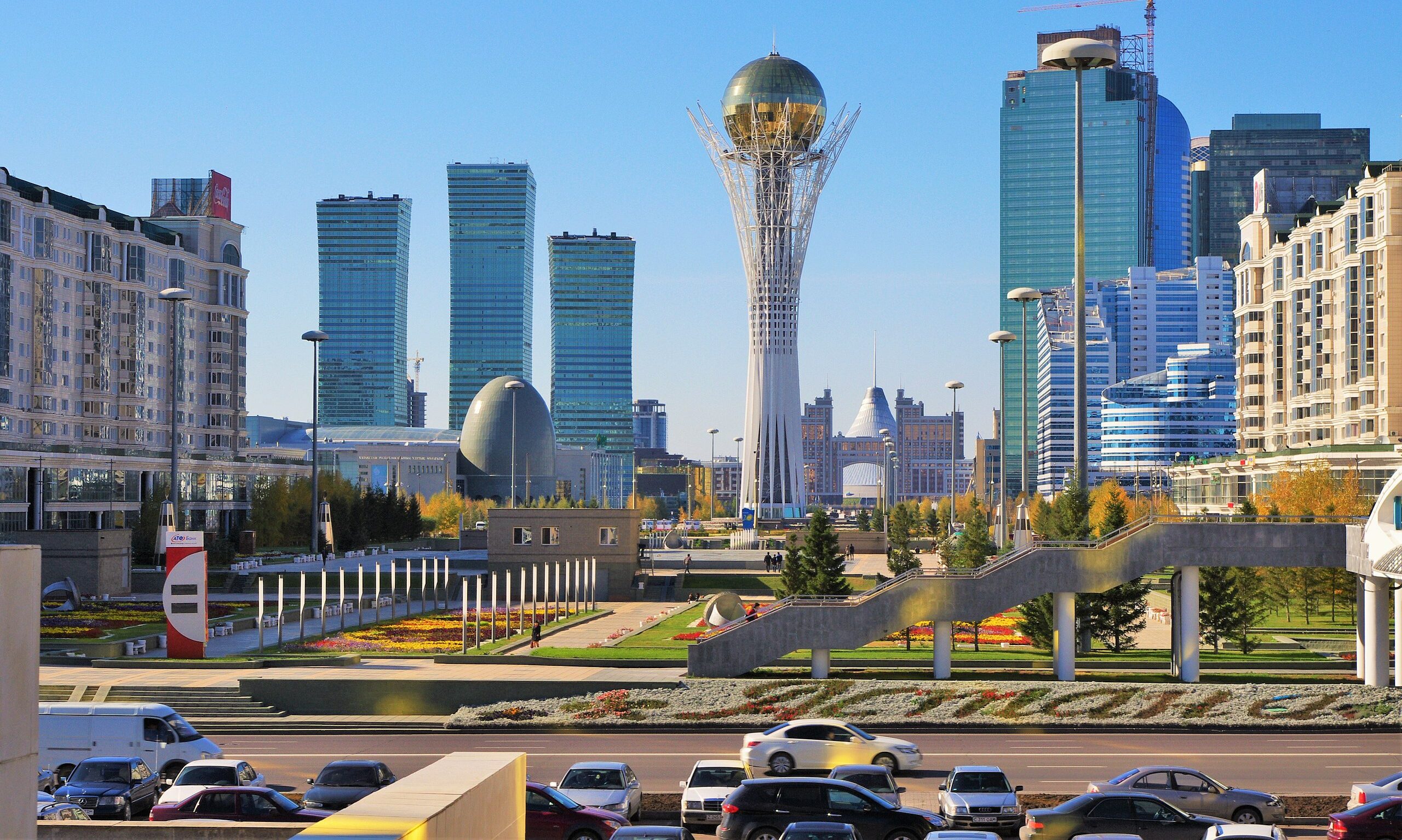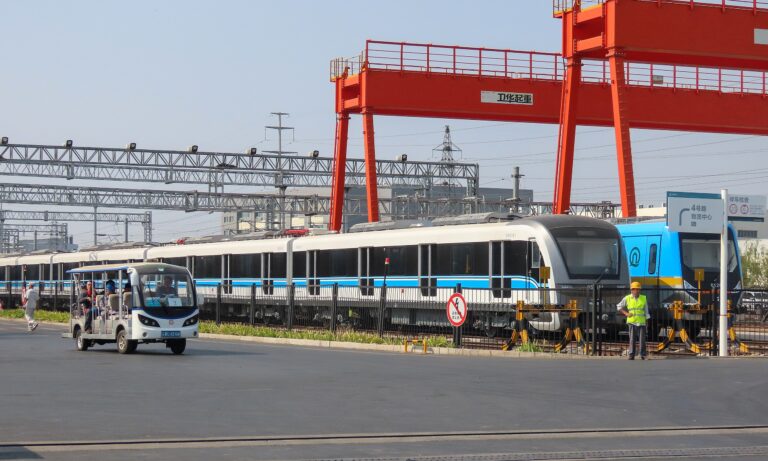China and Central Asia: Outside the Spotlight, but Always on the Table

Central Asian governments have grown used to accommodating the different priorities of outside partners and leveraging them for their own benefit, making sure not to become anyone’s playground. As Russia’s standing comes under question and China holds its ground, Western countries need to come up with an approach that is attuned to the region’s preferences.
Central Asia has never been too far from key Chinese foreign policy initiatives. In Kazakhstan almost ten years ago, President Xi Jinping announced the multibillion-dollar “Silk Road Economic Belt” project that later evolved into the Belt and Road Initiative. It was Kazakhstan and Uzbekistan, where the Chinese leader went for his first official post-pandemic foreign visit in September last year.
The Chinese engagement in the region has not gone unnoticed. Western political actors usually observe Central Asia primarily through the lenses of geopolitical ambitions, especially against China and Russia, or through terrorism-related security framework, given the proximity of Afghanistan and Iran.
In this regard, Central Asia is currently enjoying solid diplomatic interest both from the EU and the US following the Russian invasion of Ukraine last year, which has shaken Russia’s position in the region. The March visit of US Secretary Blinken to Kazakhstan and Uzbekistan underlined the growing attention paid to the region in Western capitals.
Developing and extending ties with diverse partners both within the region and beyond is promising and may benefit all countries involved. However, it is necessary to understand the specifics of Central Asia countries and societies vis-à-vis partners such as China to ensure the sustainability of the proposed projects and partnerships.
States, Regimes, and Borders
Following the USSR’s demise, the newly independent states of Central Asia launched new ties with China in trade and investment, connectivity, culture, security, and energy. Throughout the development of ties, the core principle of the relationships between all Central Asian countries and China has remained the same – the shared preference for security status quo and gradual organic development of political and economic relations, preferably under conditions compatible with other actors’ presence.
The shared border of Kazakhstan, Kyrgyzstan, Tajikistan, and the Chinese Uyghur Autonomous Region (Xinjiang) is the omnipresent factor overshadowing virtually all interactions between China and Central Asia. The borderline between China and these three countries is three thousand kilometers long, running mostly through difficult mountainous terrain. Securing this sensitive frontier from any potentially malicious or uncontrolled influence has always been a priority for China.
Besides Uyghurs, there are also large groups of Kazakh, Kyrgyz, and Tajik ethnic groups living in China. One might expect that these cross-border ties would play a significant role in bilateral relations, and criticism would be voiced strongly by Central Asians, considering their gradually strengthening ethnic nationalism. However, Central Asian countries historically usually remained neutral in the United Nations regarding resolutions on Uyghur issues; last year, especially following Xi’s official visit, they voted in favor of Beijing.
It is, however, important to realize that the region is not a monolith and the situation in each country has its own specifics. With its relatively higher economic and political weight, Kazakhstan used to address the issue of ethnic Kazakhs with China, at least unofficially. The Kyrgyz government has fewer leverages to play against China, even if they genuinely wanted to intervene. And Tajikistan, to an even larger extent than the former two, has a poor record on human rights and fears radical (in fact, any opposition) groups just as Beijing does.
Still, this does not mean that Chinese oppressive minority policies are not creating a backlash in Central Asia. The Oxus Society or the ACLED project keep tracking public protests, rallies, and other initiatives mentioning China; most of them are either organized by relatives or activists of those persecuted in Xinjiang or the labor and land-related issues mentioned above.
Going Soft, Going Hard
China’s building of soft power in Central Asia bears similarities to Beijing’s efforts in other regions of the world. Beijing has established numerous Confucius institutes, organizing language courses and cultural events; Chinese universities have opened gates to Central Asian students, offering numerous scholarships; government, business, and security officials are often invited to attend workshops and training programs in China. Nevertheless, these efforts suffered greatly during the pandemic lockdown and China’s self-isolation. Before the coronavirus outbreak, university studies in China and language learning enjoyed widespread popularity because of expected better economic prospects by their participants. However, the inability to visit China and reduced economic opportunities in the region temporarily slowed the pace of mutual contacts.
Despite actively seeking economic and political cooperation, both sides struggle with prejudices against each other. Sinophobia, especially in Kazakhstan and Kyrgyzstan is rooted in a fear of a giant neighbor that may take over the native land or vital parts of the economy. Further problems emerge from everyday interactions, revolving around different work management and culture, combined with the language barrier.
Currently, Kyrgyzstan is pioneering its relationship with China, considering the combined amount of media penetration, top-level political ties, and physical presence of Chinese private security companies and businesses. Some observers describe the country as a testing ground for Chinese influence techniques for further use in the region. However, the internal differences between the five countries are too significant to assume the others could and would quickly follow the Kyrgyz model.
Follow the Money. And Pipelines
Economic cooperation across the region has gone through several stages. Since the early 1990s, oil, and other fossil fuels have been at the center of attention. Especially in the cases of Kazakhstan and Turkmenistan, Beijing has contributed a lot to the development of domestic energy industries and infrastructure transporting energy resources to China. As a result, Turkmenistan is today the largest single gas exporter to China and seeks to further increase deliveries. Kazakhstan is much more careful with putting most of its eggs into one basket regarding oil exports, but the energy cooperation with Beijing is also extensive.
However, the scope of financing for Chinese projects in the region has gradually changed; initial huge investment campaigns (visible in other parts of the world) were replaced by more cautious, targeted, joint funding. Such a change followed not only the shift in priorities on both sides but reflected the agency of the Central Asian countries. Governments and other stakeholders managed to force the Chinese companies to pay greater attention to local needs, investing more in projects supporting local development, hiring local workers, and transferring skills and technologies.
Furthermore, Central Asian states also grew increasingly concerned about the mounting macroeconomic risks. In Kyrgyzstan, for example, China is the second largest creditor, holding $2 billion out of $5 billion total, making further large loans less attractive.
Another issue underpinning the cooperation between China and the region is connectivity. Debates about Central Asia’s transit potential for Chinese goods have been around for decades, even beyond the famous Belt and Road label. Recently, the so-called “middle transit corridor,” stretching across Central Asia from China to the Caspian Sea and finally to Europe, received unprecedented diplomatic attention because Western sanctions blocked the established transit routes through Russia.
However, the successful implementation and sustainability of the new transit routes would require large and stable investments and political determination lasting years. Besides the insufficient capacity of the existing physical infrastructure, there are persisting hurdles in cross-border administration and infamous informal practices of local authorities delaying the cargo and bringing more expenses. These obstacles can be overcome, but both infrastructure expansion and harmonization of procedures will take its time.
Security Cooperation: Together, but not Entirely
While economic ties have flourished, the focus on security has always provided a framework for China’s ties with region. The first relevant institutional grouping involving China in the region was the so-called Shanghai Five, bringing together China, Kazakhstan, Kyrgyzstan, Russia, and Tajikistan. It later evolved into the Shanghai Cooperation Organization, bringing new members, India and Pakistan, observers such as Afghanistan, Belarus, Iran, and Mongolia, and negotiating partnerships as far as Caucasus and MENA. The first and foremost task for SCO was establishing a functioning border regime and related procedures. Currently, the organization fulfills essentially the same, only updated, mission: providing a platform for regular interaction, mutual support, and legitimization for all actors involved while not carrying heavy institutional or bureaucratic burdens.
SCO’s priority is to keep consensus among the members across the region regarding a strong stance against terrorism and radicalism, especially militant Islamism. Beijing fears that any widespread unrest in Central Asia might spill over to mainland China. For this reason, China exerts significant efforts to prevent any support to radical groups that might verbally or practically challenge Chinese interests. Some radical groups inside Afghanistan (ISIS-Khorasan) already loudly criticize China and its allies for being anti-Islamic and even conduct attacks on Chinese citizens. Uzbekistan and Tajikistan have already become targets of demonstrative missile attacks and are highly motivated to cooperate with any partner, including China, on protection against such threats.
Nevertheless, China also develops security cooperation with the countries in the region on a bilateral level, considering the domestic conditions and each country’s specific needs. A unique case is the Chinese armed presence in Tajikistan on the border with Afghanistan, serving security interests both in Dushanbe and Beijing. In Kyrgyzstan, Chinese private security companies operate, protecting Chinese nationals and business interests in the country, although Beijing usually prefers to have local official security authorities do so.
With a view to establishing long-term links, China also pays attention to developing training programs to build stronger people-to-people and institution-to-institution connections and export its governance and security management model. Central Asian officials are, for example, frequently invited to funded trainings in China through which they are familiarized with Chinese security culture.
Beyond rising military trade, Chinese companies are also one of Central Asia’s largest exporters of technology and surveillance systems. The label “smart cities” is related primarily to petty criminality prevention and ensuring smooth traffic. However, these designs are bringing well-known concerns – unclear data management, personal data security worries, and potential misuse for political purposes, for example, against the opposition and activists.
Into the Future: Beyond the Competition
Within the limits of their power and position on the international scene, Central Asian states do their best to preserve their sovereignty and minimize external influence over their domestic regimes. Despite indisputable economic dependence on external actors, especially in the case of Tajikistan and Kyrgyzstan, all five countries aim to preserve their autonomous decision-making without falling into one-sided dependency, be it on Moscow, Beijing, or anyone else.
While Russian behavior toward Central Asia has become rather unpredictable, Beijing sticks to its core political priority: preserve a stable and secure neighborhood for its frontier provinces and protect its interests in the region. Vice versa, Central Asians learned how to use the Chinese economic and political presence to their benefit, along with the economic interests of Russia, the Gulf states, and others.
There is no reason for Kazakhstan, Uzbekistan, or others to abandon this model of multilateral cooperation. If the Western actors want to gain a seat at the table they will have to accommodate their adversaries’ existing interests in the region and respond to local agendas and needs besides asserting their own. So far, Beijing seems to be more skilled in this job than its Western counterparts.
Written by
Anna Jordanová
Jordanova_AnAnna Jordanová is an Associate Fellow at the Association for International Affairs (AMO), Czech Republic, focusing on post-Soviet space and energy security.


